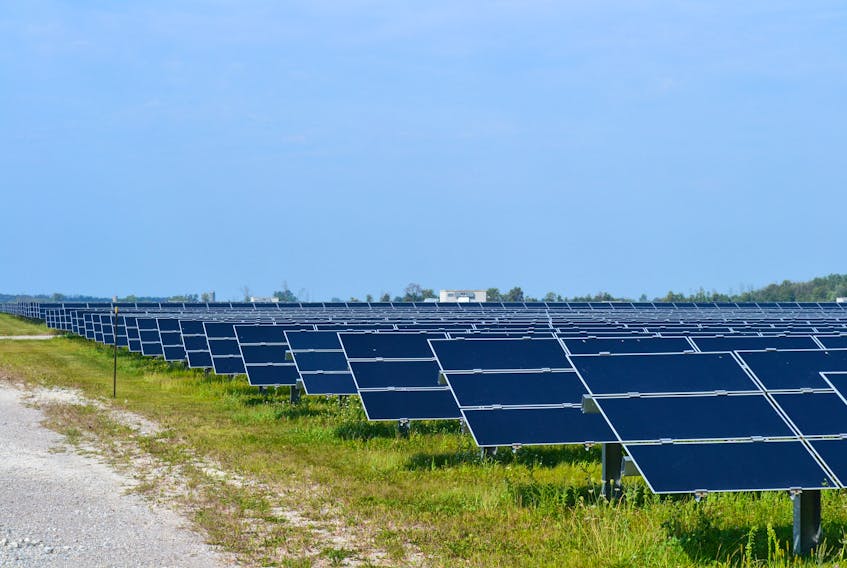YARMOUTH, N.S. — There’s a renewable energy source in southwestern Nova Scotia that has yet to be tapped in a big way.
The region holds solar radiation potential similar to the largest solar-powered station in Canada, the Sarnia Photovoltaic Power Plant, located just north of Windsor, Ont., generating 97 MW of power.
Evan Nemeth, economic development officer – research lead for WREN (Western Regional Enterprise Network), says southwest Nova is not only one of the sunniest regions in the province but also in Atlantic Canada.
“We have a photo voltaic potential equivalent to southern Ontario, just over 1 Megawatt per hour per metre squared. That would put us on par with some of the major solar generators in Canada,” he said.

Nemeth added that the western region is one of the most southern parts of Canada, and as such receives more sunlight than many other areas. Climate does impact how many sun hours an area gets, however, and the ocean complicates that with fog, but the fog doesn’t always get into the areas that are a bit further inland.
In 2011, three CBDCs partnered with NSCC’s Applied Geomatics Research Group to conduct a Southwest Nova Scotia Climate Study. The study ran until 2016, monitoring solar activity, as well as several other variables that have impacts on the growing season of crops suitable to Nova Scotia.
The study highlighted areas near Yarmouth and Weymouth as having the highest solar radiation potential.
WREN’s CEO, Angélique LeBlanc, says the work they have done has brought information together from various sources and packaged it so that it would be appealing for site selection or from an investor’s perspective.
“Our role is to really get the region investment-ready,” she said.
“When we talk about investment, it can be for local businesses to invest and grow in their own companies or to attract outside investment into the region as well.”
One of the obstacles to the opportunity that solar power presents is NS Power’s existing grid.
On a residential and small business scale, NS Power has an Enhanced Net Metering program that allows for households to draw from and contribute to the grid.
Nemeth says the grid is technically capable of taking on larger-scale renewable energy projects, but that there is limited space on the grid to allow for the transfer of energy outside of the region.
“Assuming that is correct, any larger-scale energy projects would need to be utilized locally until the transmission lines in the region are upgraded,” he said.
The Western REN has recently contracted the consultant Sustainable Solutions Group (SSG) to assist in the development of a Western Regional Energy Investment Plan.

The potential for solar energy within the region will be further investigated as well as other green energy opportunities.
The plan is meant to build upon the work that the Western REN has already conducted that highlights green energy potential by identifying opportunities for local green energy generation, storage, and/or district heating/energy facilities. When the energy investment plan is completed, the Western REN will have a better sense of the scale of the opportunities and challenges ahead.
Read the Climate Study 2016 final presentation
Associated Story
Up to 22,000 Homes in Nova Scotia Expected to Install Solar Systems by 2030 Creating Over 1,000 Jobs
HALIFAX - Nova Scotia is on track to exceed the province's renewable electricity target of 40 per cent by 2020. With the phase-out of coal-fired electricity now federally mandated, the potential for solar and other clean energy technologies presents a significant economic and environmental opportunity for the province over the next decade.
The findings of a new study prepared on behalf of the Canadian Solar Industries Association (CanSIA), predicts a bright future ahead for Nova Scotia with respect to residential solar electricity generation. The study, funded through support of the Nova Scotia Department of Energy and Mines, forecasts potential solar installations of 22,000 homes for a total of 178 megawatts by 2030. This corresponds to 190 gigawatt hours in annual renewable electricity generating approximately 1.8 per cent of the province's total electricity consumption.
The study highlights the important role of incentives from Efficiency Nova Scotia's SolarHomes Program in accelerating uptake and continued support of residential solar in the short-term. This is critical to building a strong local solar industry and unleashing job creation and economic development opportunities in Nova Scotia.
"By 2020, 40 per cent of Nova Scotia's electricity supply will be renewable as a result of the Maritime Link coming onside. Solar can play a critical role in assisting the province in achieving its coal to clean strategy," stated CanSIA Vice President Wes Johnston. "The study's projections of 1,170 solar jobs in the province by 2030 bodes well for a sustainable industry for the longer term and this number does not include commercial, industrial and institutional solar installations or the future areas of solar storage and electric vehicle charging which has additional potential."
"Nova Scotia is well positioned for strong growth in residential solar," remarked CanSIA's Policy and Regulatory Affairs Manager Lyle Goldberg. "With the cost of solar dropping significantly, coupled with high electricity rates, it's no surprise we are seeing growing interest in solar, especially with the launch of the SolarHomes Program."
Quick Facts:
Growth in Nova Scotia's residential solar market has taken off as a result of the SolarHomes Program launched in August 2018. The current program offers rebates for residential solar photovoltaic systems of $0.85 per watt up to a maximum of $8500 or 35% of eligible costs. The end of 2018 saw 530 systems installed totalling 3.4 megawatts, with an additional 200 systems (2 megawatts) ready to be deployed.
The province has over 50 companies approved to install residential solar systems under the current program. In addition to installations, the study suggests that Nova Scotia has job creation opportunities in the areas of solar distribution, research and development (given the number of post secondary institutions) and recycling solar panels at their end-of-use life cycle.
In July 2018, CanSIA hired a Policy and Regulatory Affairs Manager for Nova Scotia based in Halifax. This position was created to grow the solar market across the province by working with the local solar industry, all three orders of government, utilities and other key stakeholders.
To access the full report, click here.
To learn more about solar energy and the best way for consumers to go solar, visit the Canadian Solar Industries Association.
|
|









